-
Philippines prepares for worse disasters to come
On average, the Philippines experiences about twenty typhoons a year, including three super-typhoons and many incidents of flooding, drought, earthquakes, tremors, and occasional volcanic eruptions, making the country one of the most naturally disaster-prone areas in the world. Filipino government agencies, with the help of international disaster and relief agencies, have created new strategies for disaster preparedness, response, and mitigation which may well have potential applications in other parts of the world. As the impact of climate change grows more pronounced, the Philippines is becoming a hothouse for developing new methods and systems in the growing business of disaster relief.
-
-
Sunlight-activated nanogrid breaks down pollutants in water
Oil spills do untold damage to the environment — to the waters they pollute and to marine and other wildlife. The Deepwater Horizon spill in the Gulf of Mexico in 2010, for example, the largest accidental marine oil spill in the history of the petroleum industry, flowed unabated for three months. Typically, such oil spills are extraordinarily difficult to clean up. Soon, however, the process may become infinitely easier and ecologically friendly, the result of a new invention — “nanogrid” — a large net consisting of metal grids made of a copper tungsten oxide, that, when activated by sunlight, can break down oil from a spill, leaving only biodegradable compounds behind.
-
-
Chelyabinsk meteor explosion a "wake-up call," scientists warn
Three new studies have revealed details of the meteor that exploded above Russian city, Chelyabinsk, in February this year. Their findings provide information about the meteor’s origin, trajectory, power and damage by the airburst (the shock wave that travelled through the air from the explosion). These findings may help to refine theoretical models about the likely frequency of such events, the potential damage they could cause and hazard mitigation strategies needed for planetary protection.
-
-
Wildfire science returns to California’s Rim Fire
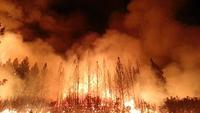
The challenging job of managing wildfires rests with other agencies, but the U.S. Geological Survey (USGS) provides the underlying science for sound land management decisions, before, during, and after wildfires. The USGS role studying natural hazards such as floods, landslides, earthquakes, and volcanoes is well known, but fewer people are aware of the USGS scientific work in major wildfire events, which are one of the most regular and sometimes most devastating natural hazards in the West.
-
-
Scientists: we should prepare for hell and high water

An international team of climate and social scientists say a new approach to climate preparedness is essential to help people adjust to coming changes. As climate-driven changes get more pronounced, people everywhere will have to adjust. In this week’s issue of the journal Science, an international group of researchers urge the development of science needed to manage climate risks and capitalize on unexpected opportunities.
-
-
Making cybersecurity a political issue
U.S. federal agencies have reported a dramatic rise in the number of cyberattacks over the past few years, with reported cyber incidents rising from 5,503 in 2006 to 48,562 in 2012. Since cyber incidents pose such a threat to national security and infrastructure, could cybersecurity become a political campaign issue? Experts say that if politicians were to focus their attention, and their constituents’ attention, on cybersecurity, the United States could be made safer from cyberattacks before a “cyber Pearl Harbor” – or a “cyber 9/11” – occurs.
-
-
Flickr photos reflect Hurricane Sandy's impact
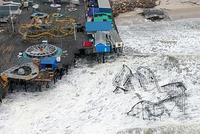
A new study has discovered a striking connection between the number of pictures of Hurricane Sandy posted on Flickr and the atmospheric pressure in New Jersey as the hurricane crashed through the U.S. state in 2012.
-
-
Resources on disaster preparedness, resilience
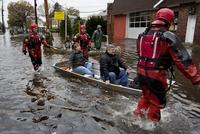
One year after Superstorm Sandy hit the eastern United States, local, state, and federal agencies as well as community groups and businesses are working to strengthen the U.S.s resilience to future disasters. A National Research Council (NRC) has issues a series of studies and reports, and has put together workshops and study groups, which should advance the national conversation on preparedness and resilience.
-
-
Rising temperatures threaten Salt Lake City’s water supply
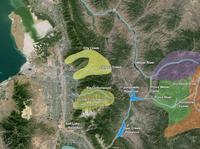
In an example of the challenges water-strapped Western cities will face in a warming world, new research shows that every degree Fahrenheit of warming in the Salt Lake City region could mean a 1.8 to 6.5 percent drop in the annual flow of streams that provide water to the city. By midcentury, warming Western temperatures may mean that some of the creeks and streams that help slake Salt Lake City’s thirst will dry up several weeks earlier in the summer and fall.
-
-
2012 sees slowdown in the increase in global CO2 emissions
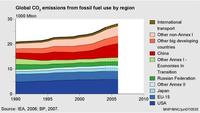
Actual global emissions of carbon dioxide (CO2) reached a new record of 34.5 billion tons in 2012. Yet, the increase in global CO2 emissions in that year slowed down to 1.1 percent, which was less than half the average annual increase of 2.9 percent over the last decade. This is remarkable, as the global economy grew by 3.5 percent. This development signals a shift toward less fossil-fuel-intensive activities, more use of renewable energy, and increased energy saving. Increases in fossil-fuel consumption in 2012 were 2.2 percent for natural gas, 0.9 percent for oil products, and 0.6 percent for coal.
-
-
Improving earthquake early warning systems
Earthquake early warning systems may provide the public with crucial seconds to prepare for severe shaking. For California, a new study suggests upgrading current technology and relocating some seismic stations would improve the warning time, particularly in areas poorly served by the existing network — south of San Francisco Bay Area to north Los Angeles and north of the San Francisco Bay Area.
-
-
Best way to stop a killer asteroid? Form a committee
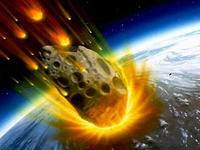
The United Nations (UN) has adopted several recommendations of a new asteroid defense plan, the first steps in preventing Earth from being struck by an asteroid. The recommendations were a response to an asteroid strike earlier this year in Chelyabinsk, Russia. This object injured thousands and was around seventeen meters across. We have only found 1 percent of these “killer” asteroids, meaning there are hundreds of times more out there than we know of. One of them, sooner or later, will have our name written on it. For a global threat we need a global response, as well as a global share of the blame if it goes wrong.
-
-
Warming will disturb nutrients balance in drylands, affecting food production
Drylands cover about 41 percent of Earth’s land surface and support more than 38 percent of the world’s population. As the world’s population grows, people will increasingly rely on marginal lands — particularly drylands — for production of food, wood and biofuels. Trouble is, an increase in aridity due to global warming will disturb the balance of nutrients in the soil and reduce productivity of the world’s drylands, a landmark study predicts. Increasing aridity is associated with a reduction in carbon and nitrogen in the soil and an increase in phosphorus.
-
-
Melting Arctic sea ice increases summer rainfall in northwest Europe
A new study offers an explanation for the extraordinary run of wet summers experienced by Britain and northwest Europe between 2007 and 2012. The study found that loss of Arctic sea ice shifts the jet stream further south than normal resulting in increased rain during the summer in northwest Europe. The annual average extent of Arctic sea ice is currently declining at about half a million square kilometers per decade — equivalent to about twice the area of the United Kingdom.
-
-
Helping first responders identify chemical, biological, and radiological agents
The U.S. Naval Research Laboratory (NRL) has expanded the reach and capabilities of its rapid urban plume modeling and hazard assessment system, CT-Analyst, by providing a commercial license to Valencia, California-based Safe Environment Engineering (SEE) for the fields of use of public safety, industrial safety and monitoring, and environmental monitoring. CT Analyst is a tool designed to provide first responders with fast and accurate predictions of chemical, biological, and radiological agent airborne transport in urban environments. CT Analyst will be integrated into the existing product line of SEE’s Lifeline MultiMeterViewer software suite.
-
More headlines
The long view
Using Drone Swarms to Fight Forest Fires
Forest fires are becoming increasingly catastrophic across the world, accelerated by climate change. Researchers are using multiple swarms of drones to tackle natural disasters like forest fires.
How Climate Change Will Affect Conflict and U.S. Military Operations
“People talk about climate change as a threat multiplier,” said Karen Sudkamp, an associate director of the Infrastructure, Immigration, and Security Operations Program within the RAND Homeland Security Research Division. “But at what point do we need to start talking about the threat multiplier actually becoming a significant threat all its own?”
